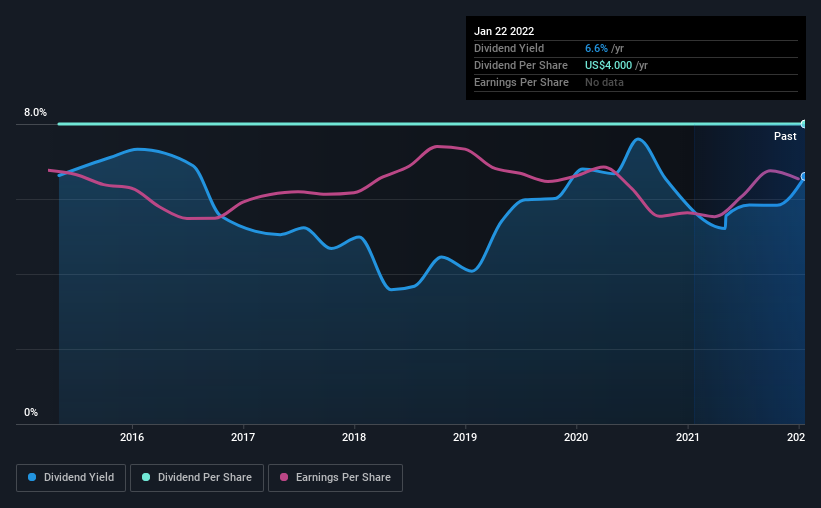We Wouldn't Be Too Quick To Buy NVE Corporation (NASDAQ:NVEC) Before It Goes Ex-Dividend
NVE Corporation (NASDAQ:NVEC) is about to trade ex-dividend in the next four days. The ex-dividend date occurs one day before the record date which is the day on which shareholders need to be on the company's books in order to receive a dividend. The ex-dividend date is an important date to be aware of as any purchase of the stock made on or after this date might mean a late settlement that doesn't show on the record date. Meaning, you will need to purchase NVE's shares before the 28th of January to receive the dividend, which will be paid on the 28th of February.
The company's next dividend payment will be US$1.00 per share, on the back of last year when the company paid a total of US$4.00 to shareholders. Calculating the last year's worth of payments shows that NVE has a trailing yield of 6.6% on the current share price of $60.57. Dividends are an important source of income to many shareholders, but the health of the business is crucial to maintaining those dividends. As a result, readers should always check whether NVE has been able to grow its dividends, or if the dividend might be cut.
Check out our latest analysis for NVE
Dividends are typically paid out of company income, so if a company pays out more than it earned, its dividend is usually at a higher risk of being cut. NVE distributed an unsustainably high 140% of its profit as dividends to shareholders last year. Without extenuating circumstances, we'd consider the dividend at risk of a cut. A useful secondary check can be to evaluate whether NVE generated enough free cash flow to afford its dividend. NVE paid out more free cash flow than it generated - 140%, to be precise - last year, which we think is concerningly high. It's hard to consistently pay out more cash than you generate without either borrowing or using company cash, so we'd wonder how the company justifies this payout level.
NVE does have a large net cash position on the balance sheet, which could fund large dividends for a time, if the company so chose. Still, smart investors know that it is better to assess dividends relative to the cash and profit generated by the business. Paying dividends out of cash on the balance sheet is not long-term sustainable.
Cash is slightly more important than profit from a dividend perspective, but given NVE's payments were not well covered by either earnings or cash flow, we are concerned about the sustainability of this dividend.
Click here to see how much of its profit NVE paid out over the last 12 months.
Have Earnings And Dividends Been Growing?
Businesses with strong growth prospects usually make the best dividend payers, because it's easier to grow dividends when earnings per share are improving. If earnings decline and the company is forced to cut its dividend, investors could watch the value of their investment go up in smoke. This is why it's a relief to see NVE earnings per share are up 2.4% per annum over the last five years. With limited earnings growth and paying out a concerningly high percentage of its earnings, the prospects of future dividend growth don't look so bright here.
Another key way to measure a company's dividend prospects is by measuring its historical rate of dividend growth. NVE's dividend payments are effectively flat on where they were seven years ago.
Final Takeaway
Is NVE an attractive dividend stock, or better left on the shelf? The dividends are not well covered by either income or free cash flow, although at least earnings per share are slowly increasing. Overall it doesn't look like the most suitable dividend stock for a long-term buy and hold investor.
With that being said, if you're still considering NVE as an investment, you'll find it beneficial to know what risks this stock is facing. Our analysis shows 2 warning signs for NVE that we strongly recommend you have a look at before investing in the company.
If you're in the market for dividend stocks, we recommend checking our list of top dividend stocks with a greater than 2% yield and an upcoming dividend.
Have feedback on this article? Concerned about the content? Get in touch with us directly. Alternatively, email editorial-team (at) simplywallst.com.
This article by Simply Wall St is general in nature. We provide commentary based on historical data and analyst forecasts only using an unbiased methodology and our articles are not intended to be financial advice. It does not constitute a recommendation to buy or sell any stock, and does not take account of your objectives, or your financial situation. We aim to bring you long-term focused analysis driven by fundamental data. Note that our analysis may not factor in the latest price-sensitive company announcements or qualitative material. Simply Wall St has no position in any stocks mentioned.

